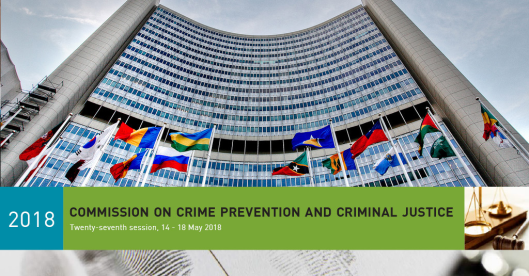"Dialogue and Diplomacy": Inka Lilja reporting from the 27th UN Crime Commission


Dialogue and diplomacy; are they synonyms, or opposites? This reflection arises from the activities of HEUNI within the past month. Firstly, HEUNI engaged with a new topic within a project titled “Depolarize". The project aims to enhance dialogue and mediation as tools to reduce conflicts between communities in Finland.
At the kick-off of the project, Mr. Bart Brandsma, a philosopher and a practitioner in conflict resolution, presented his polarization theory. The theory is based on the observation that within any given topic people fall into four roles: the pushers, the joiners, the silent, and the bridgebuilders. The pushers want to create a "us vs. them" thinking by enforcing stereotypes (such as; “all Muslims are terrorists"). The joiners are not as loud, but agree with the pushers. Then there is a silent majority, who might not be interested in the topic at all, or are of a moderate opinion. If the pushers are efficient enough, they will pull their followers further away from each other and into more and more radical thinking. If the stabilizing silent majority shrinks to a very small minority, a clash between the poles becomes inevitable. The bridgebuilders see themselves as mediators between the radically different opinions. However, often, according to Brandsma, the pushers are too far away from each other for any bridges to be built.
Instead, it would be better to take one of the following tactics to enable a dialogue:
1) instead try to engage the silent moderates in the middle into a dialogue on the topic;
2) change the subject, from the opposing and competing identities to a common question that in particular the middle group has an interest in;
3) change the tone of voice, do not moralize, do not ask who is guilty, but develop meditative speech and behavior.
I was observing the theory coming into life at the negotiations of the 27th UN Crime Commission in which I took part as a representative of HEUNI during the second week of May. The UN Crime Commission is the principle policy making body in criminal justice and crime prevention within the UN system. Each year UN Member States table draft resolutions on a variety of topics. At this 27th session the main topics of resolutions were trafficking in persons and cybercrime. A draft resolution was also introduced on restorative justice, emphasizing the need for dialogue, including with native minorities. As a side note I found it interesting to see the restorative justice reinvigorated both at the national and international level. Probably, the need for dialogue is growing in a polarized world with plenty of pushers around. As the informal and formal negotiations at the UN Crime Commission proceeded throughout the week, the most efficient negotiators used tactics recognizable from Brandsma’s model:
1) try to engage the silent member states for support;
2) change the subject – steer the negotiations to another directions eg. away from the difficult cybercrime definitions to harms caused by cybercrime, and;
3) negotiate in a meditative way trying to find common goals and common values such as protecting children from online abuse.
Still, the art of diplomacy can become a tiresome game of minor details, locked up “agreed language" and frozen positions without any room to maneuver for the negotiators. But in the end, there may be little dialogue between Member States without the UN system of diplomacy, and without diplomacy, there would be just yelling and pushing, without dialogue.
by Inka Lilja
Senior Programme Officer
The European Institute for Crime Prevention and Control, affiliated with the United Nations